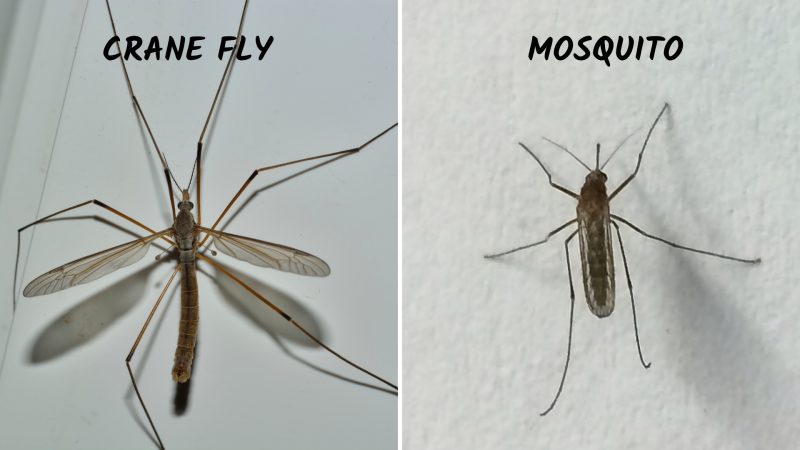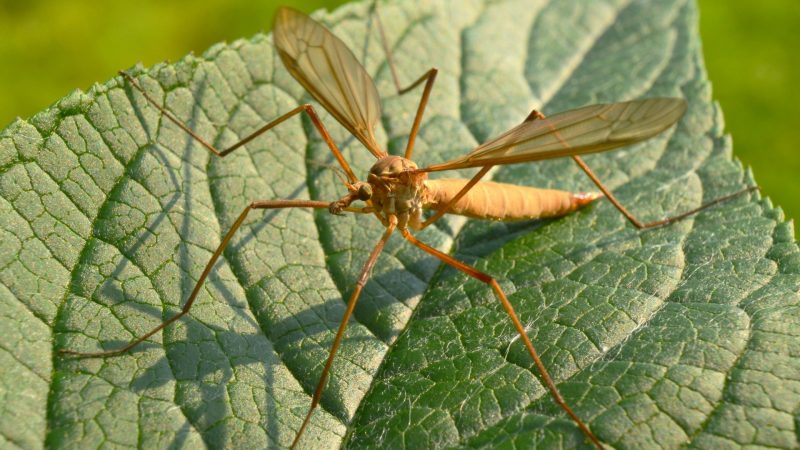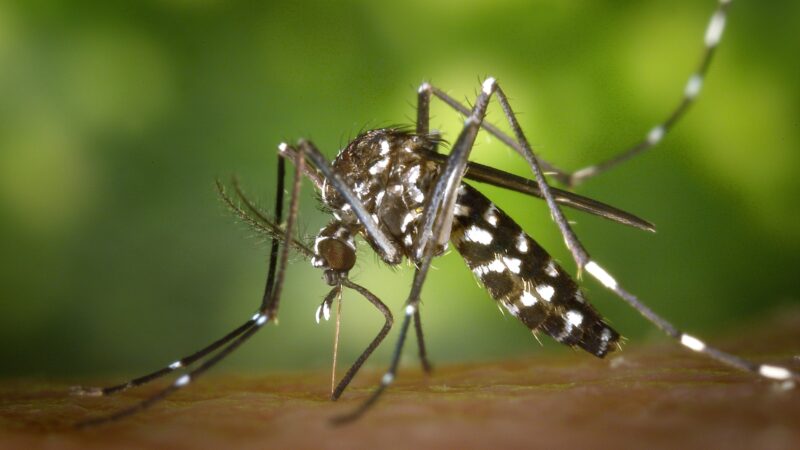At first glance, a cranefly looks a lot like a giant mosquito, which is probably the reason why many people confuse crane flies for mosquitoes. There is also a misconception that crane flies eat mosquitoes, hence mosquito eater/mosquito hawk.
What are the main differences between a cranefly and a mosquito? Mosquitos are in the family called Culicidae, while crane flies are in a family called Tipulidae. Mosquitoes also feed on plants’ fluids and human/animal blood, while adult crane flies do not feed at all.
Though very similar in appearance, these two insects are different day and night. This article will analyze the main differences between a mosquito and a mosquito eater. Let’s begin!
Difference Between Mosquito and Mosquito Eater (Crane Fly)
Crane flies are often called mosquito hawks because, due to their size and body shape, they look like giant, intimidating mosquitos. However, these two species of insects are completely unrelated and belong to an entirely different insect group.

While mosquitoes consume human and animal blood as an essential part of their diet, crane flies do not bite humans or animals. Contrary to popular belief, they do not consume mosquitos either.
The main difference is that mosquitoes are dangerous, females specifically, as they are the ones that bite. Female mosquitoes need lipids and protein to produce eggs. However, if these female warriors are carrying diseases, their bites can transmit these diseases to humans, causing illness and even death.
Crane flies, on the other hand, only eat at their larvae stage, and as they develop and emerge as adult flies, their mouthparts are unable to eat much. They do not need to bite humans and therefore do not transmit diseases.
Another difference is that crane flies lay eggs in muddy areas while mosquitoes only need an area with water – like inside your house, especially if you have indoor drains or stagnant water. Crane flies might accidentally get inside the house from time to time and quickly leave. However, mosquitoes are attracted by the human smell and tend to come inside the house and put up residency.
Does Crane Flies Eat Mosquitoes?
Despite being called mosquito eaters, crane flies do not eat mosquitos. They spend almost their whole life underground, and when they finally become adults, they do not have a mouthpart to bite anything. And their limited time as adults is spent mating, laying eggs, and waiting to die.
This misconception was fueled by the fact that they look like a larger version of a mosquito. Since they are significantly bigger than the mosquitos, someone assumed that they would prey on the smaller version of themselves, but they are just misunderstood and mislabeled. Not a single adult cranefly is a predator.
What Is a Crane Fly?

Crane fly (also known as ‘mosquito hawks’) refers to all insects in the family of Tipulidae of the order Diptera. They look the same as mosquitos, but they are not mosquitos. However, they have a slender body that looks exactly like a mosquito but with exceptionally long legs.
Unlike mosquitos, crane flies are harmless to people and animals. They are usually found near areas with an abundance of water and vegetation and rely on damp areas to breed.
A female crane fly deposits several eggs on a wet surface, which then hatches into a larva (sometimes referred to as a leather jacket due to its tough skin). The larvae feed on decaying plant tissue before entering the resting stage (pupa) in the spring. The pupa then emerges as an adult fly in the mid of the following summer.
What Do Crane Flies Eat?
Believe it or not, crane flies do not feed on anything once they reach adulthood. They do not possess mouthparts that they can use to suck blood or feed on dead plants. Out of the four stages of crane fly’s life, they only feed during their larva stage.
However, crane flies’ larvae are the ones you should be concerned about. These little ones are serious troublemakers. They feed on the roots of grass, flowers, and any other plant in the vicinity.
Adult crane flies carefully select an area with enough moisture and plantation to ensure their larva has enough to feed on once it has hatched. Therefore, if your yards are always moisturized and healthy, crane fly’s larvae may likely pose a real threat.
Does Crane Fly Bite?
Although there might be claims online of crane flies biting, they DO NOT bite or sting. As adults, crane flies have short lives and do not have mouthparts to eat, let alone bite.
How Long Does Crane Flies Live?
A crane fly has four stages in its life cycle:
- The egg stage – A female crane fly will lay eggs within 24 hours after emerging from pupae, usually in the late summer.
- Larvae stage – The eggs are then hatched into grub-like larvae. The form and color vary from one larva to the other; some are green, while others are brown. Some are plump with a distinct head, while others have slender segmented bodies.
- Pupae – By mid-spring, the larvae eventually turn into pupae. At this stage, they start emerging and can be found just above the surface.
- Adults – The pupae eventually become adult crane flies by the end of the following summer or fall. An adult crane fly usually only lives for 10 to 15 days.
Are Crane Flies Dangerous?
While these flying bugs can be a nuisance, and their larvae can potentially destroy your yard, crane flies do not bite, nor can they spread disease. There might be claims online of these insects being highly venomous, but there is no evidence to support this claim.
Crane-Fly Larvae: Do They Bite, and Are They Dangerous?
Other than being annoying lawn pests, crane fly larvae do not bite and are pretty harmless to humans and animals. These tiny creatures are usually buried in moist soil and decaying vegetation or submerged in water.
Therefore, there is minimal contact with humans and animals. Even in cases when you dig them up, they are pretty harmless and do not bite.
How to Get Rid Of the Crane Flies: Instructions
If you are worried about the ‘mosquito eater’ effects in your home, try eliminating them in their larval stage. There are various ways to achieve this. For one, you can maintain efficient drainage to allow the soil to drain off moisture, and the aeration will prevent the larvae from developing.
There are also products that you can use on your lawn and garden to get rid of them. One of the best products for getting rid of crane flies is BioAdvanced Complete Insect Killer For Soil & Turf.
- INSECT KILLER: Army worm killer. Also kills listed surface...
- LONG-LASTING PROTECTION: Kills listed soil insects for up to 3...
- VERSATILE APPLICATION: Use this ready-to-spray formula on soil,...
- MOSQUITO CONTROL: Kills mosquitos in addition to 30 other outdoor...
- EXTENSIVE COVERAGE: The 32-ounce ready-to-spray insect killer...
What Does a Mosquito Look Like?

The most prominent feature of a mosquito is the proboscis. The proboscis is the part of the mouth that enables them to suck blood and other fluids. Mosquitos are mainly gray with silver or green hair-like scales.
They also have visible white stripes across the abdomen and peculiar long legs. Mosquitos vary in size. An adult mosquito size can be anywhere from 1/4 to 3/8 of an inch (0.635 to 0.953 cm) in length.
How Long Do Mosquitoes Live?
Just like the crane flies, mosquitos have four life stages:
- Eggs – The female mosquito deposits eggs on a wet surface and can deposit up to 100 eggs at a time, which can survive for up to 8 months.
- Larva – Once the eggs get enough moisture, they hatch into larvae. Mosquito larvae depend on the microorganisms in the water to survive.
- Pupa – The larvae finally metamorphose into pupa after molting three times. The pupa stage will last 2-4 days before it grows wings and turns into an adult.
- Adults – After emerging, a male mosquito will feed on nectar while a female feeds on blood to produce eggs.
Through this whole cycle, the mosquito lives for about one or two months. However, since a female can deposit up to 100 eggs at a time, there will be many new generations born to replace them.
What Do Mosquito Bites Look Like?
Mosquito bites are not very different from other types of insect bites. They resemble bites from fleas, gnats, and even some species of spiders. After a mosquito bite, you will get a whitish or reddish bump that is puffy, round, and sometimes very itchy.
The area might even react and swell a bit. After a day or two, the area will turn reddish-brown. It’s also possible to be bitten multiple times in the same place. This could eventually result in small blisters and leave dark marks on the affected area. If you are having problems with mosquitos in the house or outside in the yard, try using the SallyeAnder No-Bite-Me Natural Bug Repellent & Anti-Itch Cream.
- ALL-NATURAL, 4-HOUR PROTECTION: Our unique blend of pure...
- 2-IN-1 BUG REPELLENT & AFTER-BITE CREAM: “No-Bite-Me” does it...
- FAST-ACTING SCENT: Active ingredients including mint, lemongrass,...
- TRUSTED BY FAMILIES FOR OVER 40 YEARS: “No-Bite-Me” is safe...
- SALLYE ANDER PROMISE: When you buy Sallye Ander products, you can...
What Do Mosquitoes Eat?
Mosquito larvae feed on algae, bacteria, and all the other microorganisms in water. Adult mosquitos (both male and female) feed on nectar and other plant juices. However, the female needs human or animal blood along with the plant diet to produce eggs.
What Attracts Mosquitoes?
The primary source of attraction for mosquitos is water and warm temperatures. In their first three stages of life, mosquitoes need water to survive. Even the tiniest drop of water might attract a female who is ready to produce eggs.
Therefore, it is essential to remove anything that can hold water for a long time to avoid attracting mosquitos. Ensure that you unclog gutters, dispose of old tires and empty flower pots, and keep old toys open and dry.
What Is the Purpose of Mosquitoes?
Believe it or not, mosquitos are helpful to the ecosystem. It might seem like they present more problems than value, but mosquitos play an essential role in the food chain. For example, they are food for fish (in larvae form) and birds (when adults). Mosquitos are also pollinators.
List of Sources
Crane Fly Redux (Family Tipulidae), University of Wisconsin
Large Crane Flies, Missouri Department of Conservation
Daniel Stolte D., What’s up with all the Crane Flies?, University of Arizona
Windbiel-Rojas K., (2016), ‘Mosquito Hawks’ in Your House?, Agriculture and Natural Resources, University of California
Merchant M., Crane flies, not Mosquitoes, Texas A&M Agrilife Extension
- How to Get Rid of Copperheads | Practical Guide - August 27, 2023
- How to Get Rid of Corn Snakes | What Makes Them Aggressive? - August 27, 2023
- How to Get Rid of Alligators | Safety Measures and Removal Methods - July 16, 2023


